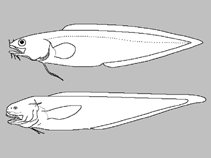Upload your photos and videos
Google imageNo image available for this species;
drawing shows typical species in Ophidiidae.
Google imageNo image available for this species;
drawing shows typical species in Ophidiidae.
Classification / Names Common names | Synonyms | Catalog of Fishes(genus, species) | ITIS | CoL | WoRMS | Cloffa
Teleostei (teleosts) > Ophidiiformes (Cusk eels) > Ophidiidae (Cusk-eels) > Neobythitinae
Etymology: Spectrunculus: Latin, spectrum = apparition (Ref. 45335).
More on author: Vaillant.
Etymology: Spectrunculus: Latin, spectrum = apparition (Ref. 45335).
More on author: Vaillant.
Environment: milieu / climate zone / depth range / distribution range Ecology
Marine; bathydemersal; depth range 1772 - 3677 m (Ref. 80689). Deep-water
Distribution Countries | FAO areas | Ecosystems | Occurrences | Point map | Introductions | Faunafri
Atlantic and eastern Pacific Oceans.
Size / Weight / Age
Short description Identification keys | Morphology | Morphometrics
Dorsal soft rays (total): 121 - 139; Anal soft rays: 91 - 102; Vertebrae: 71 - 78. This species is distinguished by the following set of characters: dorsal-fin rays 121-139; anal-fin rays 91-102; total vertebrae 71-78; otolith ostium depth 30-40% of sulcus length (Ref. 80689).
One specimen from the eastern Pacific was examined and radiographs showed the following stomach contents: detritus, gastropods, crustaceans, ophiurids, remains of polychaetes, foraminifera, sediment, and bivalves. From individuals with filled stomachs), detritus was found to be 88%, followed by gastropods (52%), crustaceans (44%), and ophiurids (36%). Observed ontogenetic trend in the consumption of gastropods with 18.2% in specimens less than 45 cm SL (n=11) and 78.6% in specimens greater than 45 cm SL (n=14, Fisher’s Exact Test, P<0.005); all gastropod shells were intact (Ref. 80689).
Life cycle and mating behavior Maturity | Reproduction | Spawning | Eggs | Fecundity | Larvae
Main reference
Upload your references | References | Coordinator | Collaborators
Uiblein, F., J.G. Nielsen and P.R. Møller, 2008. Systematics of the ophidiid genus Spectrunculus (Teleostei: Ophidiiformes) with resurrection of S. crassus. Copeia 2008(5)542-551. (Ref. 80689)
IUCN Red List Status (Ref. 130435: Version 2024-2)
Least Concern (LC) ; Date assessed: 12 October 2018
CITES
Not Evaluated
Threat to humans
Harmless
Human uses
Fisheries: of no interest
FAO - Publication: search | FishSource |
More information
Trophic ecology
Food items
Diet composition
Food consumption
Food rations
Predators
Food items
Diet composition
Food consumption
Food rations
Predators
Ecology
Ecology
Ecology
Population dynamics
Growth parameters
Max. ages / sizes
Length-weight rel.
Length-length rel.
Length-frequencies
Mass conversion
Recruitment
Abundance
Growth parameters
Max. ages / sizes
Length-weight rel.
Length-length rel.
Length-frequencies
Mass conversion
Recruitment
Abundance
Life cycle
Reproduction
Maturity
Maturity/Gills rel.
Fecundity
Spawning
Spawning aggregations
Eggs
Egg development
Larvae
Larval dynamics
Reproduction
Maturity
Maturity/Gills rel.
Fecundity
Spawning
Spawning aggregations
Eggs
Egg development
Larvae
Larval dynamics
Anatomy
Gill area
Brain
Otolith
Gill area
Brain
Otolith
Physiology
Body composition
Nutrients
Oxygen consumption
Swimming type
Swimming speed
Visual pigments
Fish sound
Diseases & Parasites
Toxicity (LC50s)
Body composition
Nutrients
Oxygen consumption
Swimming type
Swimming speed
Visual pigments
Fish sound
Diseases & Parasites
Toxicity (LC50s)
Genetics
Genetics
Heterozygosity
Heritability
Genetics
Heterozygosity
Heritability
Human related
Aquaculture systems
Aquaculture profiles
Strains
Ciguatera cases
Stamps, coins, misc.
Aquaculture systems
Aquaculture profiles
Strains
Ciguatera cases
Stamps, coins, misc.
Tools
E-book | Field guide | Length-frequency wizard | Life-history tool | Point map | Classification Tree
| Catch-MSY |
Special reports
Download XML
Internet sources
AFORO (otoliths) | Aquatic Commons | BHL | Cloffa | BOLDSystems | Websites from users | Check FishWatcher | CISTI | Catalog of Fishes: genus, species | DiscoverLife | ECOTOX | FAO - Publication: search | Faunafri | Fishipedia | Fishtrace | GenBank: genome, nucleotide | GloBI | Google Books | Google Scholar | Google | IGFA World Record | MitoFish | Otolith Atlas of Taiwan Fishes | PubMed | Reef Life Survey | Socotra Atlas | Tree of Life | Wikipedia: Go, Search | World Records Freshwater Fishing | Zoological Record
Estimates based on models
Phylogenetic diversity index (Ref. 82804): PD50 = 0.7500 [Uniqueness, from 0.5 = low to 2.0 = high].
Bayesian length-weight: a=0.01000 (0.00244 - 0.04107), b=3.04 (2.81 - 3.27), in cm total length, based on all LWR estimates for this body shape (Ref. 93245).
Trophic level (Ref. 69278): 3.7 ±0.6 se; based on size and trophs of closest relatives
Resilience (Ref. 120179): Medium, minimum population doubling time 1.4 - 4.4 years (Preliminary K or Fecundity.).
Fishing Vulnerability (Ref. 59153): Moderate to high vulnerability (48 of 100).




